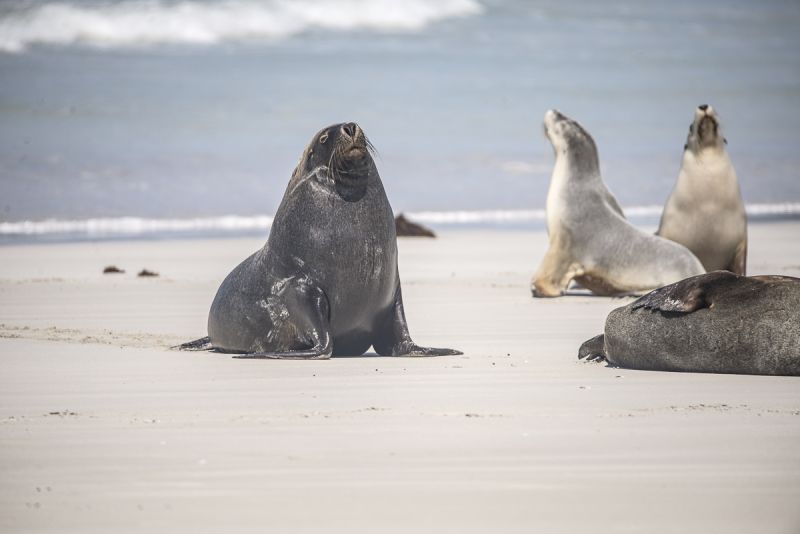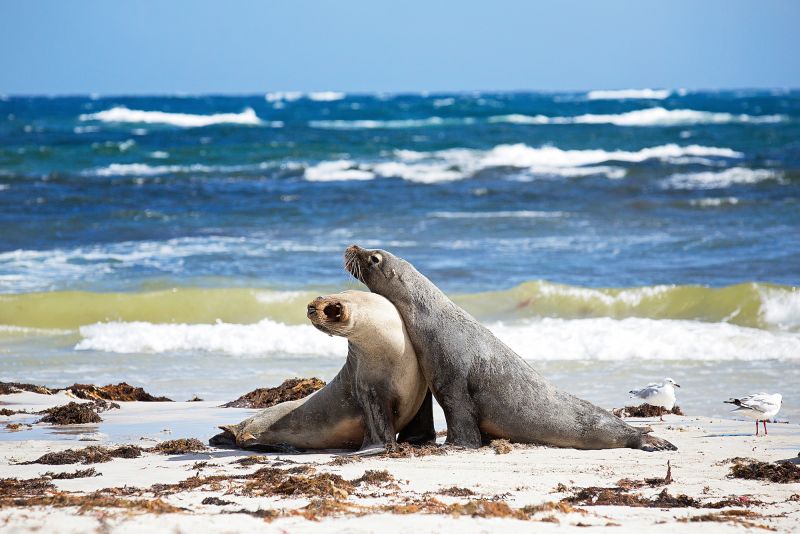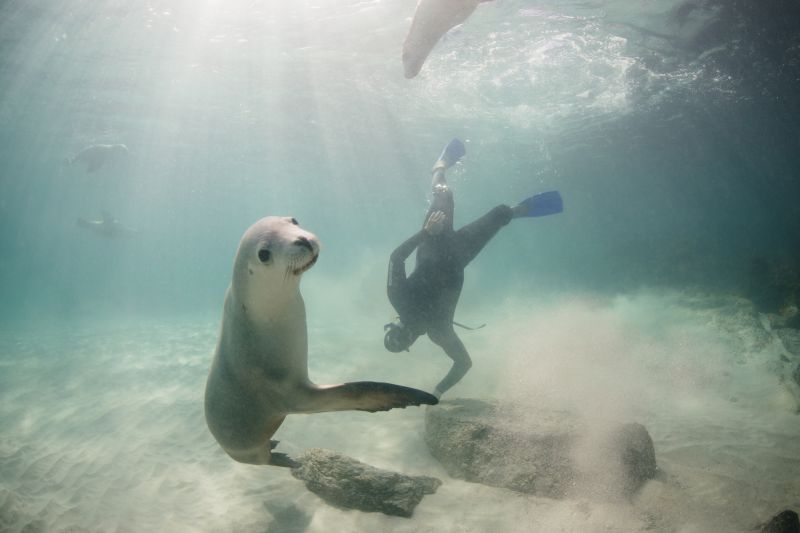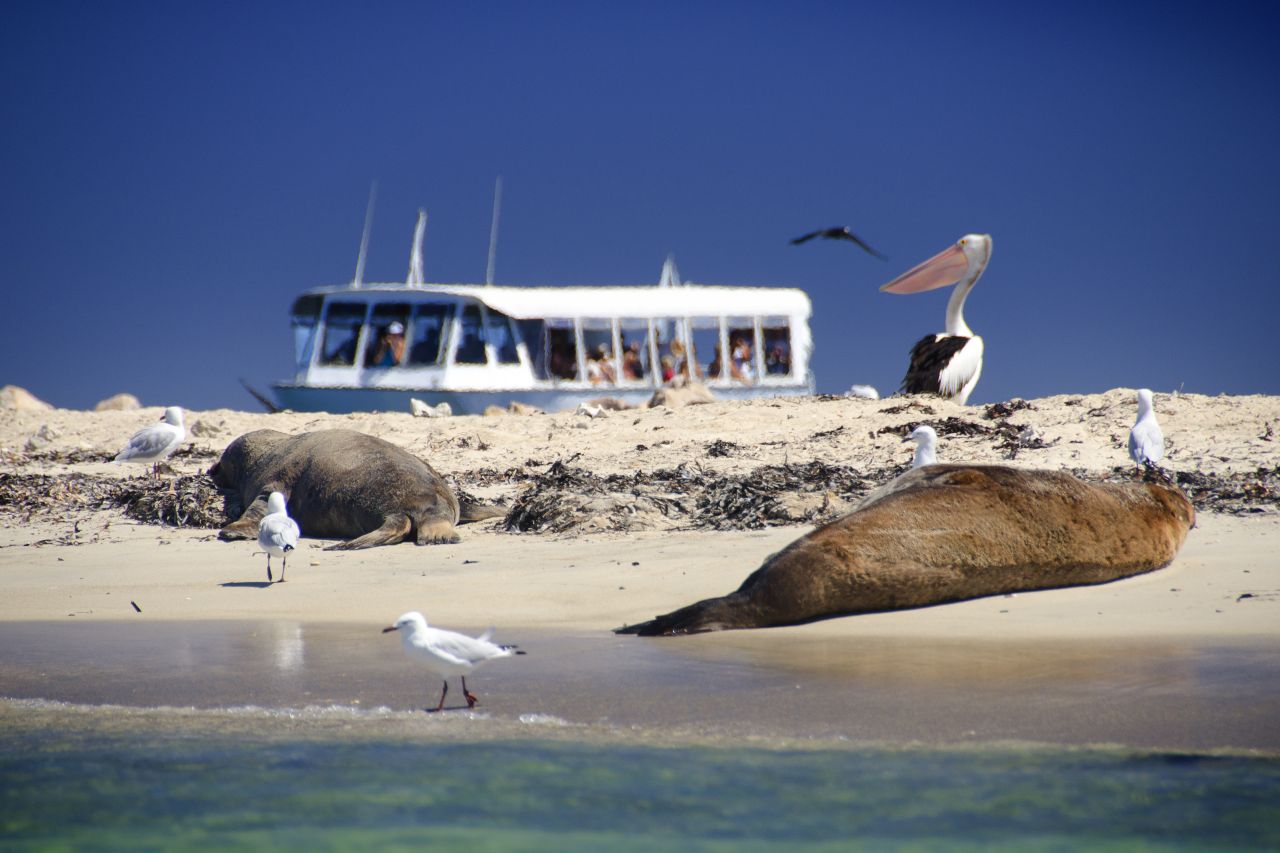Found only along the southern and western coastlines of Australia, the Australian Sea-lion (Neophoca cinerea) is one of the rarest sea-lion species in the world. Unlike their more widespread relatives, these charismatic marine mammals are endemic to Australian waters, with about 85% of the population residing in South Australia and the remaining 15% in Western Australia. Their playful nature and unique behaviours have earned them the nickname "puppy dogs of the sea," making them a favourite among wildlife enthusiasts.
Can you swim with Australian Sea-lions?
Yes, you can swim with wild Australian Sea-lions in certain locations, however operators are required to have a permit from local environmental authorities. These locations include the Eyre Peninsula in South Australia with Australian Coastal Safaris, and the Shoalwater Islands in Western Australia with Perth Wildlife Encounters.
Size and appearance
Australian Sea-lions belong to the "eared seal" family, meaning they have small external ear flaps and can walk on land using all four limbs. Their powerful front flippers help them move gracefully through the water, while their hind flippers provide steering.
Males, known as bulls, are significantly larger than females. They can grow up to 2.5 metres (8 feet) long and weigh around 300 kilograms. They develop a distinctive chocolate brown coat with a creamy yellow mane, making them easy to distinguish from females.
Females are much smaller, typically reaching 1.5 metres (5 feet) in length and weighing about 100 kilograms. Their coats are silver-grey on top and pale cream underneath. Both males and females undergo seasonal moulting, shedding their fur and replacing it with a fresh coat.

Male (darker) and female (lighter) Australian Sea-lions on the beach at Seal Bay on Kangaroo Island. Image: Exceptional Kangaroo Island
Australian Sea-lion diet
Australian Sea-lions are skilled hunters, feeding mainly on bottom-dwelling prey. They are known as benthic foragers, meaning they hunt along the sea floor rather than in open water. Their diet includes octopus & cuttlefish, rock lobsters, small sharks & rays, and various fish species.
They can dive to depths of over 100 metres (330 feet) and hold their breath for up to 12 minutes while searching for food. Unlike some other seals and sea-lions that hunt in large groups, Australian Sea-lions are mostly solitary hunters.
A recent study by the University of Adelaide and SARDI PhD candidate Nathan Angelakis, featured in the video above by Great Southern Reef, has captured groundbreaking footage of Australian sea lions using advanced hunting strategies such as flipping rocks, ambushing prey, and chasing fish, sharks, rays, and cephalopods across diverse marine habitats.
Notably, the footage provides the first visual confirmation of social learning, showing a mother sea lion taking her pup on an eight-hour hunting trip, demonstrating how to locate and catch prey, including a giant cuttlefish.
This research, supported by The Australian Government's National Environmental Science Program (NESP) Marine and Coastal Hub and The Ecological Society of Australia's Holsworth Wildlife Research Endowment, is crucial for mapping critical habitats and guiding conservation efforts for this endangered species.
Breeding
One of the most unusual characteristics of Australian Sea-lions is their irregular breeding cycle, which occurs every 17 to 18 months rather than annually. This cycle varies between different colonies, making population recovery slow and complex.
Females give birth to a single pup and care for it for up to three years, one of the longest maternal investment periods of any pinniped species. Pups rely entirely on their mothers for milk and protection, as males do not play a role in raising young. Unfortunately, only about 30% of pups survive to adulthood, making each birth critical to the species' survival.
Another unique behaviour is site fidelity—females return to the same location where they were born to give birth. This means that if a colony declines or disappears, it is unlikely to be repopulated by sea-lions from other areas.

Male Australian Sea-lions fighting at Seal Bay on Kangaroo Island. Image: Exceptional Kangaroo Island
Conservation
The Australian Sea-lion population has declined by over 60% in the past four decades, leading to its classification as Endangered under the Environment Protection and Biodiversity Conservation (EPBC) Act in 2021. Today, it is estimated that only 6,500 mature individuals remain.
Main Threats:
- Bycatch in commercial fishing – One of the biggest threats, as sea-lions often become entangled in gillnets used to catch fish. Drowning in these nets has caused significant declines in some populations.
- Overfishing – The depletion of prey species, such as rock lobster and cuttlefish, makes it harder for sea-lions to find food.
- Marine pollution – Plastic debris, discarded fishing gear, and other pollutants can harm sea-lions through entanglement or ingestion.
- Climate change – Changes in ocean temperatures and currents may affect the availability of prey.
- Boat strikes – Increasing marine traffic puts sea-lions at risk of injury or death from boat collisions.
Conservation Efforts:
Some recent conservation measures have shown promising results. In South Australia, fishing closures near breeding colonies and the introduction of cameras on commercial fishing boats have helped reduce bycatch deaths by 98%. However, in Western Australia, there are still few protections in place, particularly for small colonies where even a few deaths can be devastating.
Scientists and conservation groups continue to advocate for:
- Stronger fishing regulations to prevent bycatch.
- Marine protected areas around key breeding sites.
- Population monitoring to track recovery efforts.
Where to see Australian Sea-lions in the wild
For a chance to encounter Australian Sea-lions in their natural habitat, try one of these regions:
Kangaroo Island, South Australia
Kangaroo Island's Seal Bay Conservation Park is home to one of the largest colonies, this is the best place to see wild sea-lions basking on the beach. Exceptional Kangaroo Island offer private guided tours onto the beach, which forms part of their full-day Island Life or two-day Kangaroo Island In Style itineraries.
Eyre Peninsula, South Australia
South Australia's Eyre Peninsula offers the rare opportunity to swim with wild sea-lions in clear, shallow waters. Australian Coastal Safaris offers this experience as part of their three-day Eyre Peninsula Wildlife & Ocean Encounters.
Shoalwater Islands, Western Australia
Located just 45 minutes south of Perth, the Shoalwater Islands Marine Park is home to a colony of Australian Sea-lions who can be observed lounging on the sand or swimming in the protected bays. Perth Wildlife Encounters offers a four-hour 3 Islands Wildlife Snorkel tour, where guests can snorkel with sea-lions and dolphins.

Snorkelling with Australian Sea-lions on the Eyre Peninsula. Image: Australian Coastal Safaris
Featured Tour: Kangaroo Island In Style
Operator: Exceptional Kangaroo Island
Duration: 2 days
Discover what makes Kangaroo Island such a celebrated region, as you experience the Island's history, ecology, landscape, contemporary lifestyle, regional produce and incredible wildlife offerings. Key species regularly encountered are Koalas, Tammar Wallabies, Kangaroo Island Kangaroos, endangered Glossy Black Cockatoos, Short-beaked Echidnas, Australian Sea-lions, Long-nosed Fur-seals, Rosenberg's Goanna (warmer months) and a variety of bush birds, shorebirds and seabirds.
Featured Tour: Eyre Peninsula Wildlife & Ocean Encounters
Operator: Australian Coastal Safaris
Duration: 3 days
This three-day adventure combines the best terrestrial and marine protected areas across the region including the opportunity to swim with wild Australian Sea-Lions and Bottlenose Dolphins, see Emus, wild Koalas and Kangaroos and the Rosenbergs Goanna!
Featured Tour: 3 Islands Wildlife Snorkel
Operator: Perth Wildlife Encounters
Duration: 4 hours
Immerse yourself in the pristine waters of the Shoalwater Islands Marine Park, on a snorkel adventure to encounter Australian Sea-lions, countless fish species along with seabirds and dolphins.

Australian Sea-lions ashore on the Shoalwater Islands. Image: Perth Wildlife Encounters
FAQs
How do Australian sea lions differ from other sea lions?
Unlike other sea lions, Australian sea lions have an irregular breeding cycle and strong site fidelity. They also have a more limited range, being found only in Australian waters.
How long do Australian sea lions live?
They typically live between 17 and 25 years, although males often have shorter lifespans due to competition and injuries.
What is a pinniped?
A pinniped is a type of marine mammal that is part of the order Pinnipedia, which includes seals, sea lions, and walruses. The name Pinnipedia comes from Latin, meaning "fin-footed", referring to their specialised limbs that help them swim.

